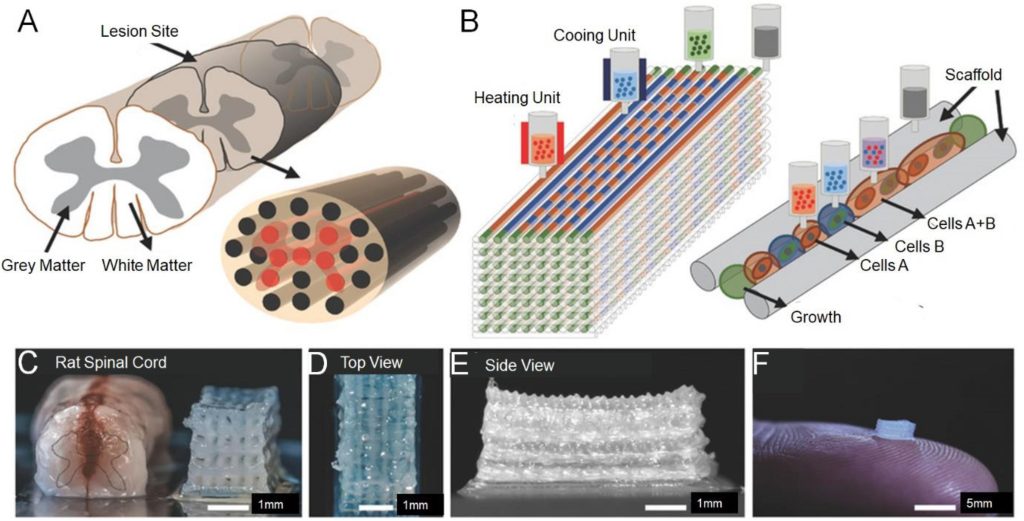Scaffolding Techniques for Brain and Spinal Cord Injuries

Objective:
To delve into the scaffolding techniques used for repairing brain and spinal cord injuries, focusing on nanomaterials and their effectiveness in promoting tissue regeneration.
Introduction to Scaffolding in Tissue Engineering:
Scaffolding is a critical technique in tissue engineering, used to support and guide the regeneration of damaged tissues. In the context of brain and spinal cord injuries, scaffolds serve as physical and biochemical structures that promote the repair of nerve tissue by mimicking the extracellular matrix (ECM) environment. These scaffolds can be designed at the nanoscale to enhance their interaction with cells and tissues, leading to better functional outcomes.
Read the full article here.
Key Features of Scaffolding Techniques:
- Nanofiber Scaffolds:
- Nanofiber scaffolds are created by electrospinning or 3D printing techniques and are widely used for nerve regeneration. These scaffolds are designed to replicate the natural environment of the ECM, providing a structure for cells to grow and regenerate.
- Example: Nanofibers made from biodegradable polymers such as polycaprolactone (PCL) or collagen have been successfully used in spinal cord injury models to guide nerve growth.
- Biodegradable Scaffolds:
- Biodegradable scaffolds are made from materials that gradually degrade as the tissue regenerates. This ensures that the scaffold does not need to be removed surgically and that the regenerated tissue is not hindered by residual materials.
- Example: Poly(lactic-co-glycolic acid) (PLGA) scaffolds are used for spinal cord injury repair, where they support nerve growth and degrade over time as new neural tissue forms.
- 3D Printed Scaffolds:
- 3D printing technology is used to create highly detailed scaffolds with precise shapes and structures that can be tailored to fit the specific needs of the patient. These scaffolds can be designed to fit the contours of a brain or spinal injury site.
- Example: 3D-printed scaffolds made from biocompatible materials have been tested for use in brain trauma recovery, allowing for precise localization of therapeutic agents and facilitating tissue repair.
- Hydrogels as Scaffolds:
- Hydrogels are water-absorbing materials that can be used as scaffolds to provide structural support while also delivering drugs or growth factors to the damaged tissue. They have been developed as a promising tool for brain and spinal cord injuries due to their ability to mimic the natural environment of brain tissues.
- Example: Gelatin-based hydrogels loaded with neurotrophic factors have been applied in spinal cord injury models, demonstrating improved cell survival and regeneration.
Applications of Scaffolding for Nerve Regeneration:
- Spinal Cord Injury Repair:
Nanoscaffolds are being used to bridge gaps in the spinal cord following traumatic injury. These scaffolds provide both structural and biochemical support to promote axonal regeneration and restore function. - Brain Injury Recovery:
Nanomaterial-based scaffolds are also being studied for use in brain injuries. These scaffolds help regenerate neurons, stimulate synapse formation, and guide axonal growth, promoting functional recovery. - Peripheral Nerve Regeneration:
In the peripheral nervous system, nanofiber scaffolds help guide the growth of nerve fibers across injury sites, enabling the regeneration of damaged nerves and improving the functional recovery of patients with nerve injuries.
Real-World Example:
- Polymeric Scaffolds for Spinal Cord Injury:
- Research into polymeric nanofiber scaffolds for spinal cord injury has shown promise, with scaffolds providing physical support and delivering growth factors that help stimulate nerve regeneration, resulting in improved motor function in preclinical studies.
Case Study:
- Biodegradable Nanofiber Scaffolds in Brain Injury:
- A study on biodegradable nanofiber scaffolds for brain injury repair demonstrated that these scaffolds promoted neural growth and synaptic connectivity in animal models, leading to improved cognitive function and recovery of lost brain tissue.